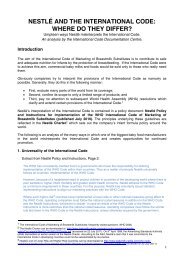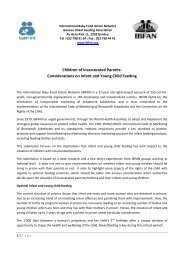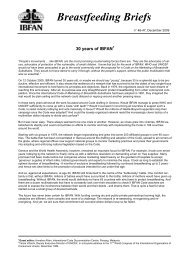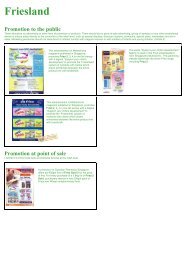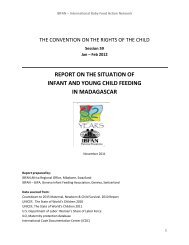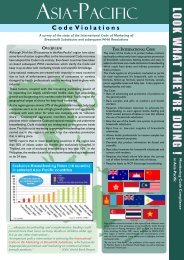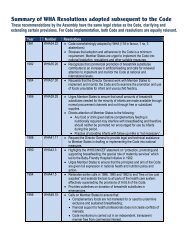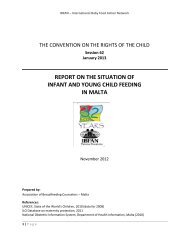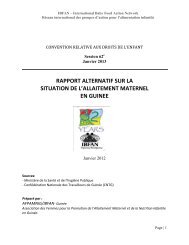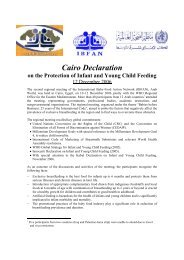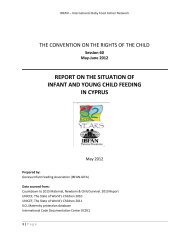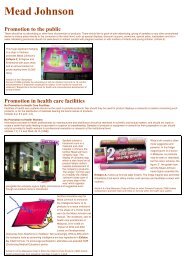You also want an ePaper? Increase the reach of your titles
YUMPU automatically turns print PDFs into web optimized ePapers that Google loves.
MILUPA<br />
� In health centres in Sudan, colorful brochures advertise<br />
Milupa cereals from four months with claims<br />
about iron fortification to “prevent anaemia, frequently<br />
seen during the weaning period”.<br />
� Doctors in Sudan receive blocks of tear-off sheets<br />
about HN25 as a solution for diarrhoea to give to<br />
mothers as “a service of Milupa”.<br />
� A fancy Milupa booklet given out by hospitals in the<br />
UAE advocates mixing Miluris (as of four months)<br />
into breastmilk or formula as a smooth start in weaning.<br />
It also promotes Milupa teas as of zero months,<br />
jarred foods after four months and soluble rusks to be<br />
disolved in breastmilk or formula.<br />
50<br />
Labelling<br />
� Article 9 of the Code requires labels to NOT discourage<br />
breastfeeding and to inform about the correct use of the<br />
product and the risk of misuse.<br />
� WHA Resolution 54.2 (2001)<br />
advises exclusive breastfeeding for 6<br />
months which means that the recommended<br />
age for use of complementary<br />
foods cannot be under 6 months.<br />
� Milutee (infant tea) labels in<br />
Serbia recommend it for use as<br />
of one week. The label shows a<br />
baby picture and is mostly in<br />
German, with only partial translation<br />
on a sticker.<br />
� The inside of Aptamil Pre boxes in Latvia advertises<br />
Aptamil 1.<br />
� In Tanzania, Milupa 7 Cereals labels recommend use<br />
from four months and claim: “The recipe contains<br />
pre-biotics which are naturally occurring nutrients<br />
similar to those found in breastmilk.”<br />
� Aptamil 1 and Milumil 1 labels in Lithuania have no<br />
important notices, no mention of the superiority of<br />
breastfeeding, and no statement that the product<br />
should be used only on the advice of a health worker,<br />
yet space is found for graphics to attract mothers.<br />
� A glossy Milupa<br />
brochure for doctors<br />
in the Sudan<br />
calls Aptamil<br />
“the first investment<br />
for a child’s<br />
future” and promotes<br />
“An Aptamil<br />
for Every<br />
Step”:Aptamil<br />
Start, Aptamil 1<br />
and 2.�<br />
Breaking the Rules, Stretching the Rules 2004<br />
Misleading text and pictures<br />
which violate the Code<br />
� Article 4.2 requires all information material to advocate<br />
for breastfeeding and not contain pictures or text which<br />
idealises the use of breastmilk substitutes.<br />
� A leaflet in Ghana compares<br />
the protein, fat and carbohydrate<br />
content of breastmilk,<br />
cow’s milk and Aptamil 1 in<br />
a bar graph to show Aptamil<br />
1 has a “special composition<br />
close to breastmilk”. It makes<br />
other claims comparing<br />
Aptamil 1 with breastmilk.�<br />
� A leaflet in Macedonia promotes Milumil 1, Milumil<br />
2 and Milubrei cereal, saying the products “remove<br />
problems in children who eat too fast” and the rich<br />
content of complex carbohydrates will make “chil-<br />
dren relaxed and<br />
calm through the<br />
night”.<br />
� In Ghana, a Milupa poster for its wheat & fruits cereal<br />
shows a baby with a bunch of fruits on its head<br />
and has the caption “Milupa cereals as natural as<br />
nature intended”. The product is recommended for<br />
use from 4 months.�<br />
International Baby Food Action Network -- <strong>IBFAN</strong>



